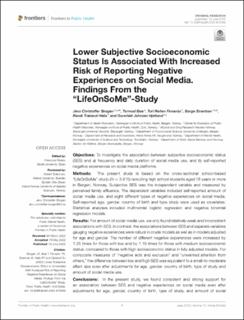| dc.contributor.author | Skogen, Jens Christoffer | |
| dc.contributor.author | Bøe, Tormod | |
| dc.contributor.author | Finserås, Turi Reiten | |
| dc.contributor.author | Sivertsen, Børge | |
| dc.contributor.author | Hella, Randi Træland | |
| dc.contributor.author | Hjetland, Gunnhild Johnsen | |
| dc.date.accessioned | 2022-10-24T12:22:53Z | |
| dc.date.available | 2022-10-24T12:22:53Z | |
| dc.date.created | 2022-09-26T14:00:12Z | |
| dc.date.issued | 2022 | |
| dc.identifier.issn | 2296-2565 | |
| dc.identifier.uri | https://hdl.handle.net/11250/3027958 | |
| dc.description.abstract | Objectives: To investigate the association between subjective socioeconomic status (SES) and a) frequency and daily duration of social media use, and b) self-reported negative experiences on social media platforms. Methods: The present study is based on the cross-sectional school-based “LifeOnSoMe”-study (N = 3,415) recruiting high school students aged 16 years or more in Bergen, Norway. Subjective SES was the independent variable and measured by perceived family affluence. The dependent variables included self-reported amount of social media use, and eight different types of negative experiences on social media. Self-reported age, gender, country of birth and type study were used as covariates. Statistical analyses included multinomial logistic regression and negative binomial regression models. Results: For amount of social media use, we only found relatively weak and inconsistent associations with SES. In contrast, the associations between SES and separate variables gauging negative experiences were robust in crude models as well as in models adjusted for age and gender. The number of different negative experiences were increased by 1.25 times for those with low and by 1.10 times for those with medium socioeconomic status, compared to those with high socioeconomic status in fully adjusted models. For composite measures of “negative acts and exclusion” and “unwanted attention from others,” the difference between low and high SES was equivalent to a small-to-moderate effect size even after adjustments for age, gender, country of birth, type of study and amount of social media use. Conclusions: In the present study, we found consistent and strong support for an association between SES and negative experiences on social media even after adjustments for age, gender, country of birth, type of study, and amount of social media use. The potential link between SES and negative experiences on social media as reported in this study is likely to have a public health impact. As the reported findings are novel, they need to be replicated in forthcoming studies based on other study populations. Future research should also focus on other aspects of SES and negative experiences, as well as endeavor to investigate potential longitudinal associations. | en_US |
| dc.language.iso | eng | en_US |
| dc.publisher | Frontiers | en_US |
| dc.rights | Navngivelse 4.0 Internasjonal | * |
| dc.rights.uri | http://creativecommons.org/licenses/by/4.0/deed.no | * |
| dc.title | Lower Subjective Socioeconomic Status Is Associated With Increased Risk of Reporting Negative Experiences on Social Media. Findings From the “LifeOnSoMe”-Study | en_US |
| dc.type | Journal article | en_US |
| dc.type | Peer reviewed | en_US |
| dc.description.version | publishedVersion | en_US |
| dc.rights.holder | Copyright 2022 The Author(s) | en_US |
| dc.source.articlenumber | 873463 | en_US |
| cristin.ispublished | true | |
| cristin.fulltext | original | |
| cristin.qualitycode | 1 | |
| dc.identifier.doi | 10.3389/fpubh.2022.873463 | |
| dc.identifier.cristin | 2055522 | |
| dc.source.journal | Frontiers in Public Health | en_US |
| dc.identifier.citation | Frontiers in Public Health. 2022, 10, 873463. | en_US |
| dc.source.volume | 10 | en_US |

